Antioxidant,antimicrobial and cytotoxic potential of condensed tannins from Leucaena leucocephala hybrid-Rendang
2016-06-15MzniAuZrinHoYinWnAzizulIshNurdinArmni
Mzni Au ZrinHo Yin WnAzizul IshNurdin Armni
a Laboratory of Vaccines and Immunotherapeutics,Institute of Bioscience,Universiti Putra Malaysia,43400 UPM Serdang,Selangor,Malaysia
b Laboratory of Natural Products,Institute of Bioscience,Universiti Putra Malaysia,43400 UPM Serdang,Selangor,Malaysia
c Department of Biomedical Science,Faculty of Medicine and Health Sciences,Universiti Putra Malaysia,43400 UPM Serdang,Selangor,Malaysia
Abstract Condensed tannins (CTs) are one of the promising compounds due to their potentially health-promoting qualities. In this study, CTs were extracted from a Leucaena leucocephala hybrid-Rendang and subjected to various biological studies including antioxidant(using Ferric reducing antioxidant power(FRAP),DPPH and ABTS radical scavenging assay),anti-microbial(against different pathogens)and cytotoxic activities(toward human breast adenocarcinoma(MCF-7),human colon carcinoma(HT29),human cervical carcinoma(HeLa)and human liver carcinoma(HepG2)cell lines)in cancer cells through in vitro experiments.The structural characteristics and purity of CTs extract were determined using 13C NMR.The results showed that CTs exhibited higher in vitro antioxidant activities(2257.12±80.55 mg TEAC/g extract,605.3±1.82 mg TEAC/g extract and 1014.03±1.20 mg TEAC/g extract in FRAP,ABTS and DPPH assay,respectively)and demonstrated anti-microbial activities toward selected Gram’s positive and Gram’s negative bacteria tested with MIC and MBC value at 6.25–50 mg/mL.Furthermore,among other selected cancer cells,CTs also demonstrated cytotoxic activity toward human breast cancer cells(MCF-7)(IC50=38.33±2.08 μg/mL).Characteristic of apoptosis such as cell shrinkage, nuclear condensation and apoptotic bodies were shown in MCF-7. These preliminary investigations have provided scientifi rationale to use CTs as an alternative therapy for various oxidative and inflammator associated diseases.©2016 Beijing Academy of Food Sciences.Production and hosting by Elsevier B.V.All rights reserved.
Keywords: Antioxidant;Anti-microbial;Condensed tannins;Cytotoxic;Leucaena leucocephala
1. Introduction
Since natural product-derived dugs frequently seem to be less toxic and more effective,identificatio and investigation of antioxidant, antimicrobial and anti-cancer agents from natural substances have been one of the research interests in recent years.Antioxidants scavenge variety of free radicals and reactive oxygen species and it can be extremely important in inhibiting oxidative mechanisms that lead to degenerative diseases [1].Free radicals have been implicated as playing a role in the etiology of cardiovascular disease,cancer,Alzheimer’s disease,Parkinson’s disease, etc. Although several modern drugs are used to treat this type of disorder, their prolonged use may cause severe adverse side effects on chronic administration[2].Cancer is the largest single cause of death in both men and women. Cancer is a class of diseases characterized by out of control of cell growth.There are different types of cancer,and each is classifie by the type of cell that is initially affected.Cancer harms the body when altered cells divide uncontrollably to form lumps or masses of tissue called tumors except for leukemia where cancer prohibits normal blood function by abnormal cell division in the blood stream.
Breast cancer is the most common cancer in women followed by cervical cancer;with about more than 55%of breast cancer related deaths occur in the developing world.The incidence of this disease is increasing in both industrialized and developing countries [3]. Considerable progress has been made in treating breast cancer through surgery,radiotherapy,chemotherapy,and hormone therapy [4]. However, those carcinomas that do not express the estrogen remain generally resistant to therapy.Almostallcasesofcervicalcancerwerefrompersistentinfection with one of about 15 genotypes of carcinogenic human papillomavirus(HPV)[5].Cases are often detected at late stages due to non-existent or inadequate screening,and the standard treatment options are often absent or unaffordable.Colon cancer is cancer of the large intestine.Most cases of colon cancer begin as small,noncancerous (benign) clumps of cells called adenomatouspolypsandovertime,someofthesepolypsbecomecolon cancers. Meanwhile liver cancer is one of the major causes of malignancy-related deaths worldwide, and its incidence is on the rise.Typical treatment approaches to liver and colon cancer include surgery,radiotherapy,chemotherapy and transplantation but cure rates are not satisfactory[6].To date,many anticancer drugs have been developed and applied by clinical doctors but recently, resistance to anticancer drugs was discovered; therefore, there is a need to develop new anticancer agents with minimum side effects.
Leucaena leucocephalahybrid-Rendang, which is known as the ‘miracle tree’ available in large quantities and abundant resources as well underutilize in Malaysia. This tree is a thornless tree which may grow up to 18 m and has a wide variety of uses, especially as a protein supplement for animals [7]. In Malaysia, aLeucaenahybrid,L. leucocephalahybrid-Rendang, which was produced from crossingL. leucocephalaandLeucaena diversifolia[8], was found to have high condensed tannin content and low digestibility [9]. Condensed tannins (CTs), also known as proanthocyanidins, are polymers of 2–50 (or more) fl vonoid units that are joined by carbon-carbon bonds, which are not susceptible to being cleaved by hydrolysis and most CTs are water soluble [10].Condensed tannins health benefit extend far beyond their antioxidant properties and also anti-inflammator [11], antiasthmatic [12], anticancer [13], anti-viral, anti-carcinogenic,anti-allergy,antimicrobial,antihypertension and cardiovascular system-protective [14]. Condensed tannins help wounds heal,reduce the pain from pancreatitis, reduce insulin resistance in diabetics, help protect from drug toxicity and also can help lower the levels of low-density lipoproteins,or the“bad”cholesterol. Antioxidants also decrease the oxidation of low density lipoproteins (LDL), which may lead to the buildup of plaque on the walls of arteries. Most of the previous study was done on reduction of methane and volatile fatty acid production in rumen digestion system using condensed tannins extract fromL. leucocephala[15,16]. Thus, this study was conducted due to unexplored of condensed tannins fromL. leucocephalaon antioxidant,antimicrobial and cytotoxic activities.
The principal objective of the current exposition was therefore, to utilize and investigate the biological activities of CTs extract fromL. leucocephalahybrid-Rendang including antioxidant using ferric reducing antioxidant power (FRAP),DPPH radical scavenging assay and ABTS radical scavenging assay, antimicrobial againstStaphylococcus aureus(MRSA),Staphylococcus aureus,Staphylococcus epidermidis,Pseudomonas aeruginosa,Acinetobacter anitratus,Bacillus subtilis,Escherichia coli,Proteus vulgaris,Serratia marcescens,Enterococcus faecium,Streptococcus faecalis,Candida albicans,Candida tropicalis, andAspergillus nigerand cytotoxic activities toward human breast adenocarcinoma (Mcf-7), human colon carcinoma(HT29),human cervical carcinoma(HeLa)and human liver carcinoma(HepG2)cell lines whereas purity of the compound were confirme by13C NMR spectroscopy. These preliminary investigations will provide scientifi rationale to use CTs fromL.leucocephalaas an alternative therapy for various inflammator associated diseases.
2. Materials and methods
2.1. Chemicals
Acetone and sodium carbonate (Na2CO3) were obtained from R&M chemicals, diethyl ether, gallic acid and ethanol were purchased from Merck KGaA (Darmstadt, Germany),potassium ferricyanide, iron(III) chloride (FeCl3), potassium persulphate were purchased from Pronadisa Chemie Brunschwig AG (Switzerland) trichloroacetic acid (TCA),Trolox (2,5,7,8-tetramethylchroman-2-carboxylic acid), 2,2'-azino-bis(3-ethylbenzothiazoline-6-sulphonic acid) (ABTS),1,1-diphenyl-2-picryl hydrazyl (DPPH), nystatin, ampicillin,streptomycin, penicillin, 3-(4,5-dimethylthiazol-2-yl)-2,5-diphenyltetrazolium bromide (MTT) solution and dimethyl sulfoxide (DMSO) were purchased from Sigma–Aldrich Co.(St. Louis, MO, USA), nutrient agar (NA), Potato Dextrose Agar (PDA), Sabouraud agar (SDA) were purchased from Difco (BD, USA), RPMI 1640 and fetal bovine serum were purchased from PAA Laboratories GmBH(Pasching,Austria).Methanol was purchased from Thermo Fisher Scientifi Inc.(United State)and Folin–Ciocalteu reagent was purchased from Fluka Analytical, Sigma–Aldrich Co. (St. Louis, MO, USA).All other reagents were of analytical and HPLC grades.
2.2. Plant material
Young leaves (3–4 layers from shoot) ofL. leucocephalahybrid-Rendang was collected from a farm at Universiti Putra Malaysia.These plant materials were identifie by our botanist,Dr Shamsul Khamis, Institute of Bioscience, Universiti Putra Malaysia and same material was stored at Herbarium for further identification
2.3. Extraction and purification of condensed tannin
The leaves were cut into small pieces; freeze dried and then ground using a 0.5 mm sieve.The condensed tannins from the ground leaves were extracted as previously described[17].Briefl , 5 g of ground leaves was soaked in 200 mL aqueous acetone solution (70%, v/v) for 20 min. After centrifugation(3500×gfor10 min),thesupernatantwasfiltere undervacuum to remove any particulate plant residues and washed with diethyl ether(ratio 1:1)to remove chlorophyll,pigments and low molecular weight phenolic acids. The bottom layer of the mixture(yellow) was collected and evaporated using a vacuum rotary evaporator at<40◦C.The crude extract was re-dissolved in 40%(v/v)of methanol(ratio 1:1)and stored at 4◦C.Purificatio of condensed tannins extract was carried out using a Sephadex LH-20 column(GE Healthcare Bio-Sciences AB,Uppsala,Sweden)with 40%(v/v)methanol and 80%(v/v)acetone as the respective purificatio solvents.In the purificatio process,low molecular weight phenolics were eluted with 40%(v/v)methanol,and the condensed tannins were eluted with 80%(v/v)of acetone.Purifie condensed tannins were evaporated using rotary evaporator prior to freeze dried and stored at −20◦C.
2.4. 13C NMR analysis
25 mg of the purifie CT were dissolved in 1 mL of D2O/acetone-d6(1:1) mixture. Spectra were obtained using 400 MHzJeolNMRspectrometer(ECX400II).Experimentwas conducted at 45◦C and was carried out using 20,000 scans.The resulting spectra was manually phased and baseline correction.The chemical shifts were reported relative to tetramethylsilane(0 ppm),usingacetonepeakat30.7 ppmasasecondarystandard.
2.5. Total phenolic content
Total phenolic compounds were determined with Folin–Ciocalteu reagent using gallic acid as standard.One mL of crude extract or purifie condensed tannins was diluted with 46 mL of distilled water.One mL of Folin–Ciocalteu reagent was added and the content in the flas were mixed thoroughly.After 3 min,3 mL of Na2CO3(2%, w/v) was added and the mixture were allowedtostandfor2 hwithintermittentshaking.Blankwasprepared by replacing 1 mL of condensed tannins extract with 1 mL of deionized water.The absorbance of the mixture was measured against blank at 765 nm by using UV-light spectrophotometer(Pharmaspec UV-1700, Shimadzu, Kyoto, Japan). Gallic acid was used to calibrate the standard curve. Each crude extract was analyzed in triplicate and the results were expressed in milligrams of gallic acid equivalents per gram of extract sample(mg GAE/g extract).
2.6. Determination of antioxidant activity of condensed tannins
2.6.1. Ferric reducing antioxidant power(FRAP)
The reducing power of condensed tannins was determined as described by Amarowicz et al. [18]. The suspension of condensed tannins in 1 mL of distilled water was mixed with 2.5 mL of 0.2 mol/L phosphate buffer (pH 6.6) and 2.5 mL of 1% potassium ferricyanide. The mixture was incubated at 50◦C for 20 min. A total of 2.5 mL of trichloroacetic acid(TCA)was added and the mixture were then be centrifuged at 1750×gfor 10 min. About 2.5 mL aliquot of the upper layer was mixed with 2.5 mL of distilled water and 0.5 mL of 0.1%FeCl3,and the absorbance was read at 700 nm.Trolox was used as a standard for construction of the calibration curve and the reducing power was reported as Trolox equivalent per gram of extract(mg TEAC/g extract).
2.6.2. DPPH radical scavenging assay
The free radical scavenging activity of the condensed tannin was evaluated by the DPPH according to the method previously proposed by Blois[19]with modifications Briefl ,195 μL of 0.1 mmol/L DPPH solution were added into 50 μL of condensed tannin in a 96-well plate. The mixture was incubated in the dark at room temperature for 1 h. The absorbance was measured at 540 nm using Elisa reader (Bio Tek Instruments,Inc.,Vermont,United States).The degree of scavenging activity was calculated by the following Eq.(1)and expressed as in milligram Trolox equivalent antioxidant capacity per gram of extract(mg TEAC/g extract).

2.6.3. ABTS radical scavenging assay
2,2'-Azino-bis(3-ethylbenzothiazoline-6-sulphonic acid)radical cation (ABTS+) was produced by reacting 7 mmol/L ABTS stock solution with 2.45 mmol/L potassium persulphate in a ratio 1:1(v/v)and allowing the mixture to stand in the dark at room temperature for 12–16 h before used. The absorbance of ABTS+ solution was equilibrated to an absorbance of 0.7±0.02 at 734 nm using the spectrophotometer by diluting with ethanol before used.Two hundred microlitre of condensed tannins (6.25–100 μg) was mixed with 1.8 mL of diluted ABTS+ solution. The absorbance was taken at 734 nm after 7 min using spectrophotometer. Simultaneously, absorbance of negative control (1.8 mL of ABTS radical solution and 0.2 mL of ethanol) was also measured at 734 nm. The radical scavenging capacity of ABTS(%)was calculated as following Eq. (2) and expressed as mg Trolox equivalent per gram of extract (mg TEAC/g extract). Trolox solution was used to calibrate the standard curve.

where As=absorbance of sample at 734 nm and Ac=absorbance of negative control at 734 nm.
2.7. Determination of antimicrobial activity
2.7.1. Preparation of pathogenic microbes
Clinical isolates of the following organisms:Methicillin Resistant Staphylococcus aureus(MRSA),S. aureus,S. epidermidis,P. aeruginosa,A. anitratus,B. subtilis,E. coli,P.vulgaris,S. marcescens,E. faecium,S. faecalis,C. albicans,C. tropicalis, andA. nigerthat were used in this study were obtained from Institute Medical of Research (IMR) and from the culture collection of the Institute of Bioscience,UPM.The followingreferencestrainswerealsoincludedinthestudy:Pseudomonas aeruginosaATCC 60690,Salmonella choleraesuisATCC S974,Bacillus subtilisATCC B29 andSaccharomycescerevisiaeATCC 20341.The bacterial strains were grown and maintained on nutrient agar (NA) slant, while yeast and fungi on Potato Dextrose Agar(PDA)slant.
2.7.2. Disk diffusion assay
Preliminary screening was performed by the disk diffusion method. Antimicrobial activity is based on clear zone formed around the disk. Complete inhibition was indicated by a clear zone, while partial inhibition by a semi-clear zone. Nystatin(100 mg/mL)was used as the reference drug for antifungal and anti-yeast activity while streptomycin(100 mg/mL)for antibacterial activity.Sterile distilled water(dH2O)was used as negative control.The test microorganisms(105bacteria or yeast cells/mL or 105spore/mL)were seeded onto respective medium by using steriled cotton swab.The filte paper discs impregnated with the extracts were placed on test microorganism-seeded plates.The plates were incubated at 37◦C for 24 h.All tests were performed in triplicate and the antibacterial activity was expressed as the mean of inhibition diameters(mm)produced.
2.7.3. Determination of minimum inhibitory concentrations(MIC)and minimum bactericidal concentrations(MBC)
Only microbes which showed positive results in preliminary screening were selected for this study.The MBC and MIC value was determined by the liquid dilution method. Various concentrations of condensed tannins (ranging from 0.391 to 100 mg/mL)and10 μLofstandardizedsuspensionbacteriawere placed in each test tube.The tubes were incubated at 37◦C for 24 h.The lowest concentration which did not show any growth of the tested microorganism after macroscopic evaluation was determined as the MIC and the lowest concentration of condensed tannins that does not yield any growth is the MBC.The tests were performed in triplicate.
2.8. Determination of cytotoxic activity of condensed tannins
2.8.1. Cancer cells
Human breast adenocarcinoma (Mcf-7), human colon carcinoma(HT29),human cervical carcinoma(HeLa)and human liver carcinoma (HepG2) cell lines purchased from the American Type Culture Collection (ATCC), USA were used for the cytotoxicity test.Non-tumorigenic Swiss mouse embryo fibro blast (3T3 F442A) was purchased from the Health Protection Agency (HPA) Culture Collection. The cells were grown in RPMI 1640 supplemented with 10%fetal bovine serum,penicillin(100 μg/mL)and streptomycin(100 μg/mL).The cultures were maintained at 37◦C in a humidifie atmosphere of 5%CO2.
2.8.2. Cytotoxicity assay
The MTT assay was performed to evaluate the cytotoxicity of the condensed tannin.Briefl ,1×105cell/mL were exposed to different concentration(15–150 μg/mL)of condensed tannin for 72 h.The untreated cells were also included.Subsequently,a total of 20 μL of MTT solution(5 mg/mL)were added to each well.After 4 h of incubation,the supernatant were discarded and 100 μL of DMSO were added to each well to dissolve the darkblue formazan crystals.The absorbance was measured at 570 nm using Elisa reader(Bio Tek Instruments,Inc.,Vermont,United States).Data were calculated as the percentage of inhibition and average of IC50was reported.
2.8.3. Morphological studies
The cells were treated with different concentration of condensed tannin (25–100 μg/mL) for 24, 48 and 72 h. The morphological changes including characteristic of apoptosis or necrosis of the cells were observed under an inverted light microscope(Olympus,USA).
2.9. Statistical analysis
Analyses were performed in triplicates and the data were statistically evaluated using analysis of variance(ANOVA)with SPSS15.0version.Duncan’smultiplerangetestswascarriedout in order to test any significan differences between the results.Significanc levels were define usingp<0.05.
3. Results and discussions
3.1. 13C NMR analysis
The purity of the tannin preparation can be determined by studying the13C NMR spectra. Various researchers have used13C NMR in their study of tannin [20–24]. Fig. 1 shows the13C NMR spectrum of condensed tannins fromL. leucocephalaleaves.The signal assignment was made based on the publication of Czochanska et al. [20]. Procyanidin (PC) and prodelphidin(PD)units were observed in the spectrum which is typical signals due to condensed tannins.The peaks at 116 ppm(C2', C5'), 120 ppm (C6'), and 144 ppm (C3', C4') show the presence of PC units (catechin/epicatechin). PD units (gallocatechin/epigallocatechin) signals were detectable at 146 ppm.The peaks in region between 30 and 90 ppm were typical signals C2, C3, and C4 in fl van-3-ol units. The two signals at 76 and 81 ppm were recognizable as 2,3-cisand 2,3-transisomers, respectively. This indicated that both the stereoisomers co-exist,while the signal at 78 ppm was detectable ascisform.The signals at 70 and 66 ppm were assignable to the C3 terminal and extension units, respectively. The13C NMR spectroscopy confirme the purity of CT extract and the efficien y of the extraction.
3.2. Total phenolic contents
To determine the total phenolic content, calibration curves was obtained using known quantities of standard gallic acid.Total phenolic content of the crude extract compared to purifie CTs were measured using the Folin–Ciocalteu method in terms of gallic acid equivalent. The total phenolic content of crude extract was 3.21 mg GAE/g extract while purifie condensed tannins was obtained at 2.06 mg GAE/g extract.Nepeta melissifolia,Phlomis lanataandOriganum vulgaredemonstrated the highest total phenol content with more than 15.0 mg GAE/g dried sample meanwhileGeranium purpureum,Matricaria chamomillaandLavandula veraseemed to have less than 7 mg GAE/g dried sample [24]. These results have shown that higher phenolic content than the present result due to the methanol solvent used to removes sugar and low molecular weight of phenolic compound in the extraction and purificatio method of CTs[25].

Fig.1. 13C NMR(500 MHz)spectrum of condensed tannins from Leucaena leucocephala leaves in acetone-d6/D2O(PC:procyanidin;PD:prodelphidin t:terminal unit;m:middle unit;e:extension unit).
Folin–Ciocalteu reagent determines total phenols,producing blue color by reducing yellow heteropolyphosphomolybatetungstate anions [26]. Phenolic compounds are a class of antioxidant agents acting as free radical terminators and also plant metabolites characterized by the presence of several phenol [27]. Some of them are very reactive in neutralizing free radicals by donating a hydrogen atom or an electron,chelating metal ions in aqueous solutions.Previous studies were reported that phenolic compounds are associated with antioxidant activity and play an important role in stabilizing lipid peroxidation[28].Studies also have shown that consumption of foods and beverages rich in phenolic content is correlated with reduced the risk of atherosclerosis and cardiovascular disease[29].Besides,the phenolic compounds possess multiple biological properties including anti-tumor,and antibacterial properties,and these activities might be related to their antioxidant activity.
3.3. Antioxidant activities of condensed tannins
In this study, CTs exhibited highest antioxidant activity in FRAP (2257.12±80.55 mg TEAC/g extract) compared to DPPH (1014.03±1.20 mg TEAC/g extract) and ABTS(605.3±1.82 mg TEAC/g extract) assay. Trolox was used as control for all antioxidant assays. Figs. 2–4 showed the trend of the activity for all assay including Trolox. According to the results, the antioxidant activities of CTs increased in concentration-dependent manner.
Condensed tannins showed significan different activities compared to Trolox in DPPH and ABTS assay withp<0.05,excluded for 25 μg/mL of ABTS assay. Meanwhile, CTs was not significan different at concentration of 3.125–12.5 μg/mL in FRAP assay compared to Trolox.CTs also demonstrated higher or equivalent activities to Trolox which means that CTs could be one of the potential sources for antioxidant agent as well as Trolox.
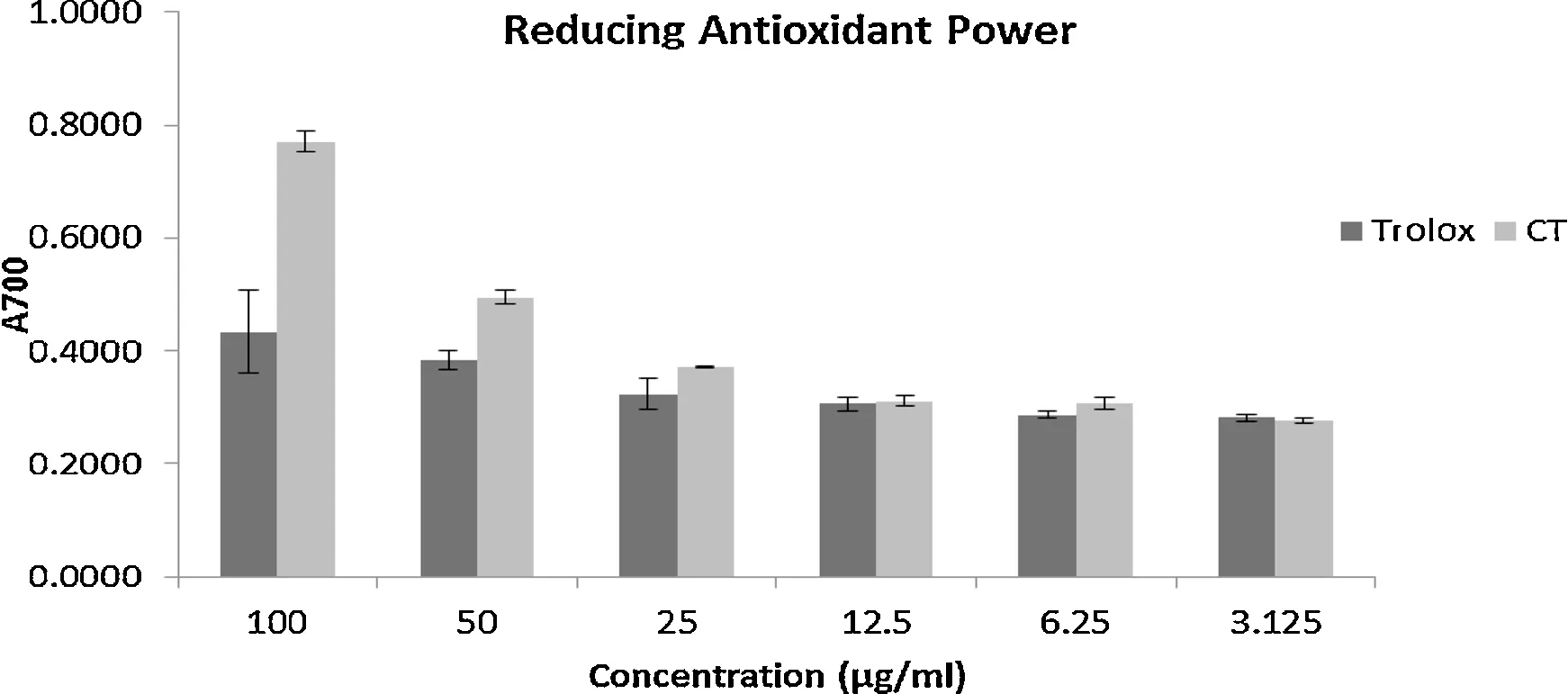
Fig. 2. Reducing antioxidant power activity of CTs and Trolox at different concentrations. No significan different was showed at concentration of 3.125–12.5 μg/mL.
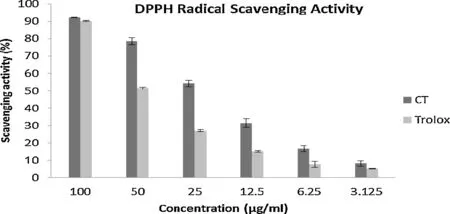
Fig. 3. DPPH radical scavenging activity of CTs and Trolox at different concentrations.
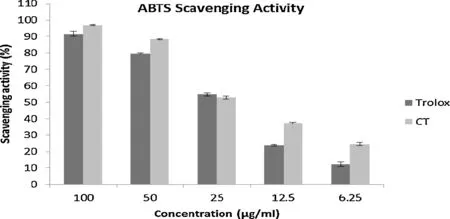
Fig.4. ABTS scavenging activity of CTs and Trolox at different concentrations.There was no significan different at concentration of 25 μg/mL.
Ferric reducing antioxidant power (FRAP) is a measurement of Fe3+reductive to Fe2+by donating an electron,which is an important mechanism of phenolic antioxidant action.The amount of Fe2+complex can then be monitored by measuring the formation of Perl’s Prussian blue at 700 nm [30].Increasing absorbance at 700 nm indicates an increase in the reductive ability. Extract fromAloe vera,Bacopa monniera,
Moringa oleiferaandZingiber officinaleshowed reducing antioxidant power activity range 0.038±0.015 to 0.119±0.086 at 100 μg/mL compared to standard BHT and Vitamin C which were 0.702±0.076 and 1.315±0.030,respectively[31].According to the result,CTs extract showed higher activity compared to previous study and can be one of the reductive potential and could serve as electron donor.
The electron donation ability of natural products can be measured by 2,20-diphenyl-1-picrylhydrazyl radical (DPPH)purple-colored solution bleaching where the method is based on scavenging of DPPH through the addition of a radical species or antioxidant that decolourizes the DPPH solution.The degree of color change is proportional to the concentration and potency of the antioxidants[32].Meanwhile,ABTS radical scavenging assay involves a method that generates a blue/green ABTS+chromophore via the reaction of ABTS and potassium persulfate.In the present study,the scavenging of the DPPH radical by the extracts was found to be much higher than that of ABTS+radical which means that the CTs extract can be considered as radical scavenger.The present finding was in agreement with previous finding Wei et al.[33]showed that the CTs extracted fromMachilus pauhoileaves inhibited the activity of DPPH radicals in a dose-dependent manner where at 100 μg/mL, the scavenging activity ofM. pauhoileaves (52.86%) was higher than that of ascorbic acid(50.65%)and BHA(45.63%).
Antioxidant is group of substances that are useful for fight ing cancer and other processes that potentially lead to disease.Unlike cytotoxic agents that damage tumor cells, antioxidant act by preventing the onset of cancer during carcinogenesis and generally beneficia to cells [34]. Reactive oxidants (reactive oxygen and nitrogen species) can cause damage to macromolecules such as proteins, lipids, enzymes and DNA [35].Therefore,living organisms produce enzymes such as catalase,superoxide dismutase and peroxides or rely on non-enzymatic molecules (e.g.: ascorbic acid, fl vonoids and vitamin K) to combat this radicals.Various studies have emphasized specifi classes such as fl vonoids and tannins which were proven to possess antioxidant capabilities [36,37]. Therefore, since CTs fromL.leucocephalahybrid-Rendang exhibited higher antioxidant activities, this extract can become one of the potential antioxidant agents.
3.4. Antimicrobial activity of condensed tannins
The CTs extract was tested on a Gram’s positive and negative bacteria and yeasts as well.In the disk-diffusion test,CTs was exhibited antibacterial activity against certain Gram’s positive and Gram’s negative bacteria (Table 1). The highest zone of inhibition(12 mm)was observed atS.epidermidis,followed by
S.choleraesuis,P.vulgaris,E.faecium,B.subtilis,A.anitratus,S. aureus, and the least was found withS. faecaliswhich produced 7.0 mm diameter inhibition zone. Additionally, the CTs demonstrated no inhibition toward yeast which suggested that bacteria are more sensitive to CTs than yeast.The resistance of fungal species against CTs could be due to their morphologicalstructure where fungi have thicker walls and contain high percentage of chitin[38].
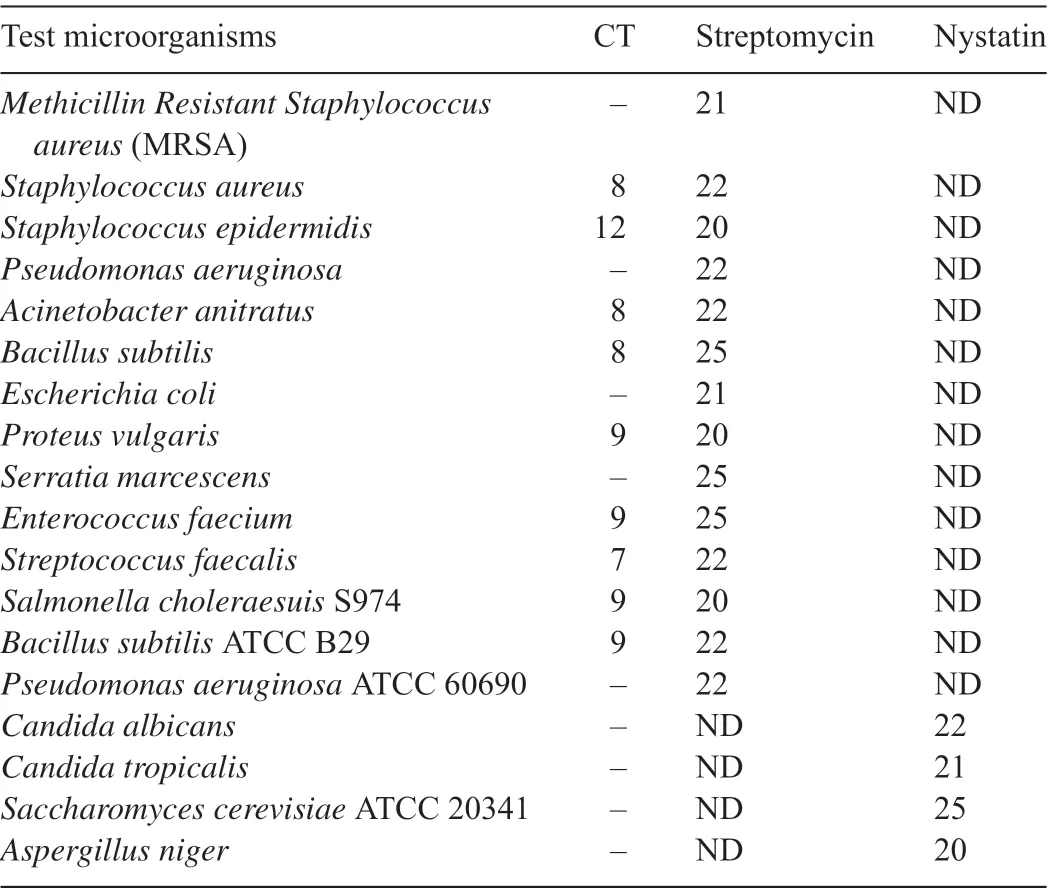
Table 1 Antimicrobial activities of condensed tannin extracted from L. leucocephala hybrid-Rendang.
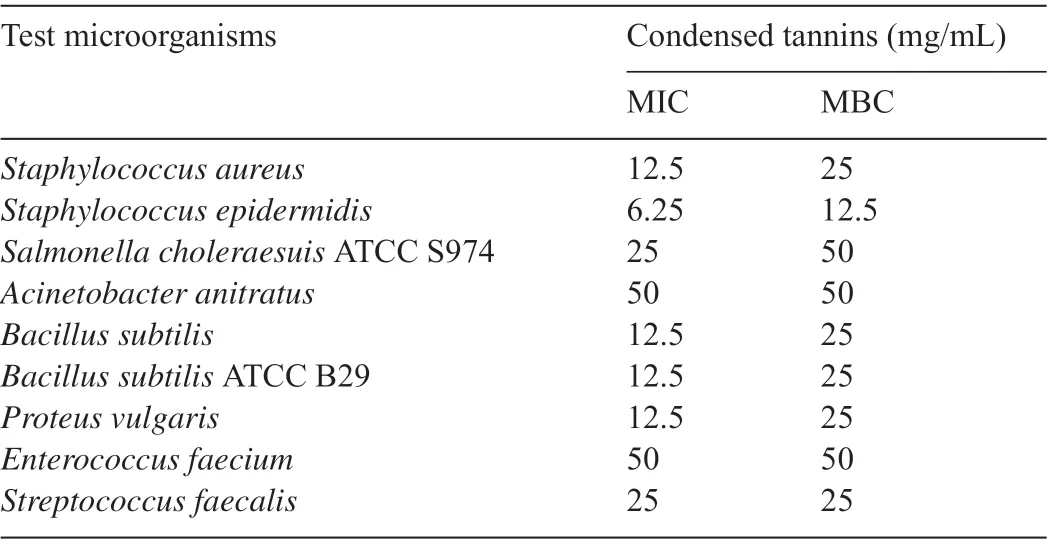
Table 2 Minimum inhibition concentration and minimum bactericidal concentration of condensed tannin extract on selected bacteria.
The MIC values of the selected bacteria were ranged from 6.25to50.0 mg/mLwhileMBSwasbetween12.5and50 mg/mL(Table 2). Since each bacterium showed different MIC/MBC value, it was suggests that different bacteria possess different degrees of sensitivity to antimicrobial compounds such as CTs.Previous study showed CTs had antimicrobial activity towardC.albicans,S.cerevisiae,S.marcescensandP.aeruginosawith MIC/MBC/MFC value range 3.15–25.0 mg/mL but in this study the results showed otherwise[39–41].This was probably due to the different sources of plants which make the CTs had different degrees of biological activity where it depends on their chemical structure and concentration[33].
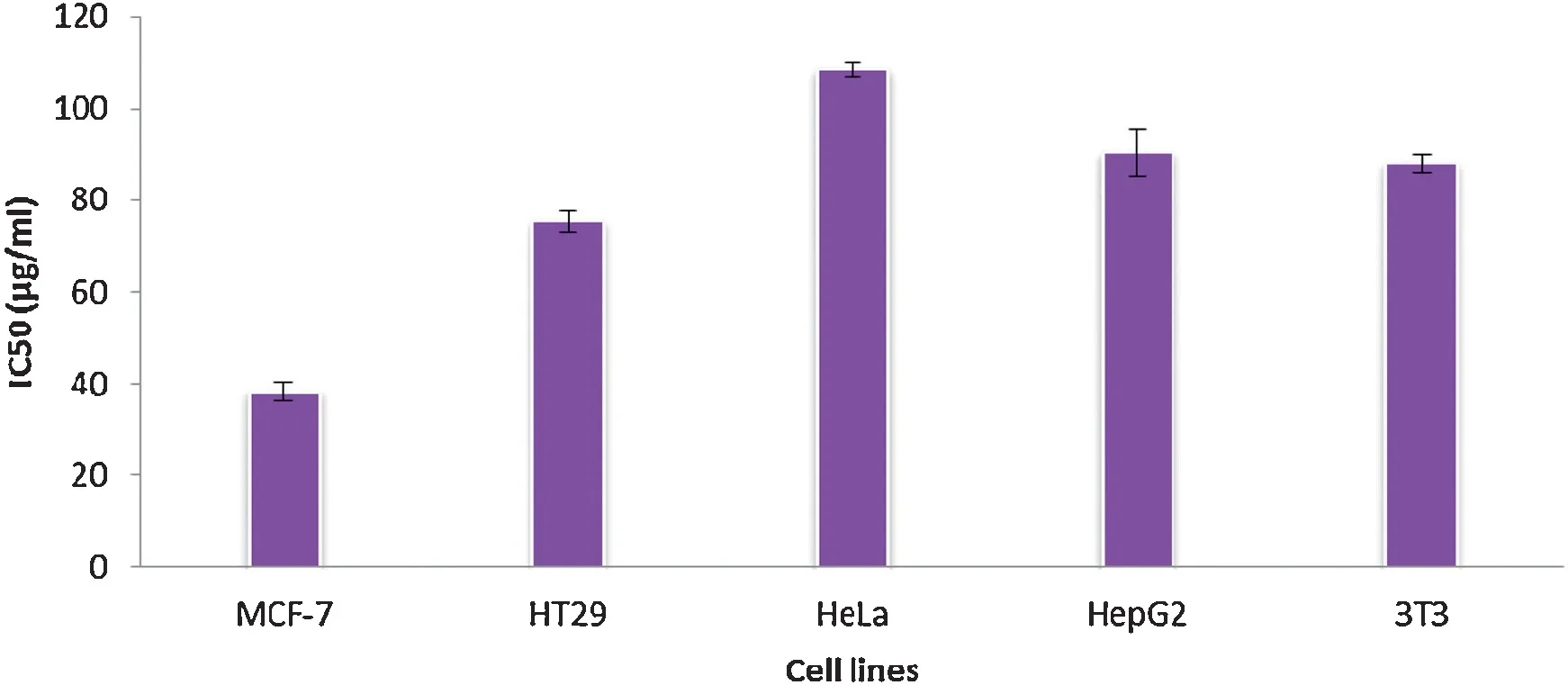
Fig.5. The IC50 of selected cancer cell lines treated with CTs of L.leucocephala hybrid-Rendang as compared to non-tumorigenic(3T3)after 72 h of incubation as determined by MTT assay.Values are presented as mean±standard deviation(S.D.).p<0.05 as compared to the 3T3 cell lines.
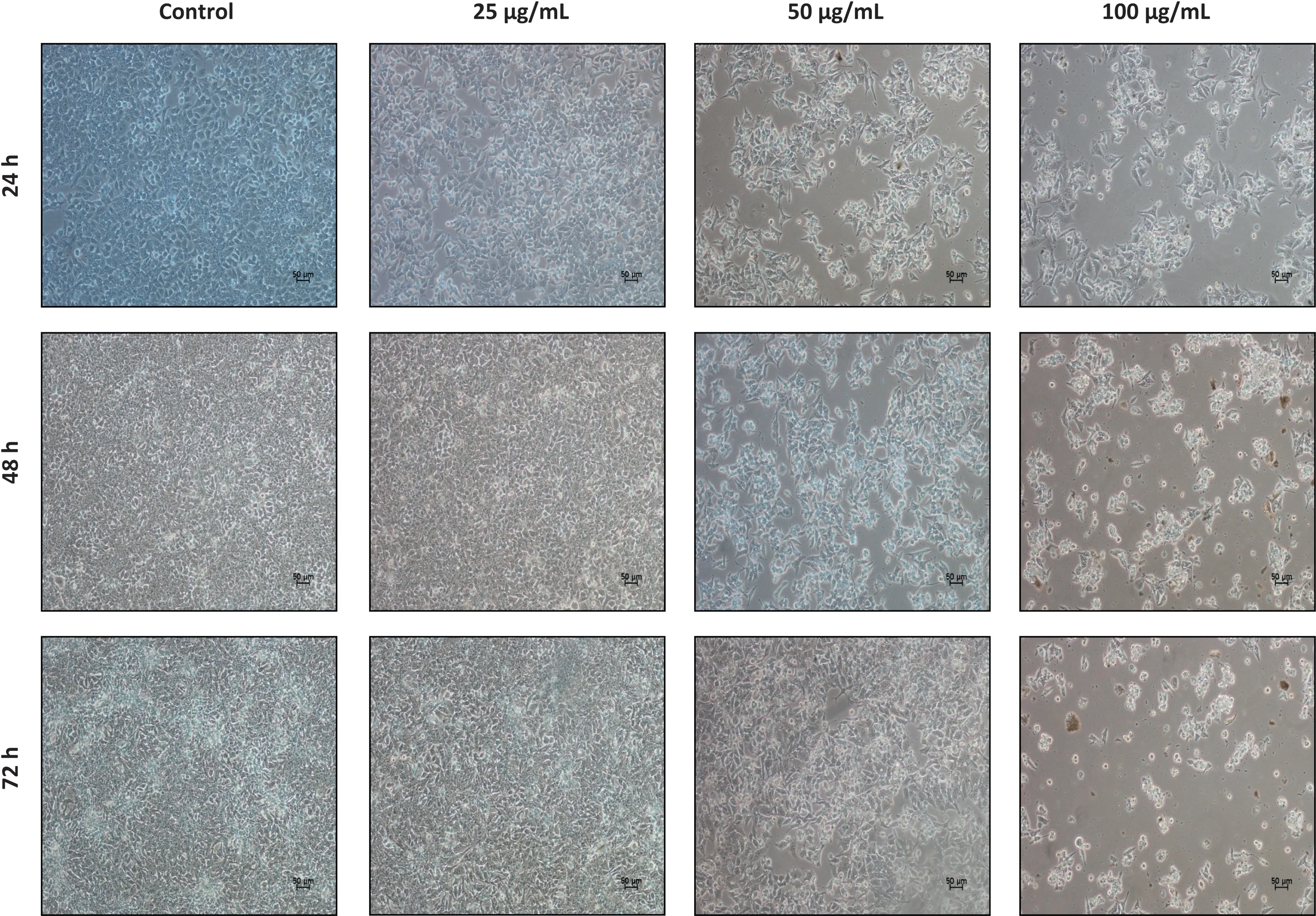
Fig.6. Morphological changes of HepG2 cells treated with different concentration CTs of L.leucocephala hybrid-Rendang for 24,48 and 72 h.The cells population was reduced in concentration-dependent manner as compared to untreated cells(100×magnification)

Fig.7. Morphological changes of HT29 cells treated with different concentration of CTs of L.leucocephala hybrid-Rendang for 24,48 and 72 h.The cells population was reduced in concentration-dependent manner as compared to untreated cells(100×magnification)
Almost all selected bacteria were categorized as Gram’s positive group and related to skin disease.S.epidermidisstrains are often resistant to antibiotics, including penicillin, amoxicillin and methicillin.The ability to form biofilm on plastic devices is a major virulence factor forS.epidermidis.In the present study,CTs showed inhibition againstS.epidermidiswhich means that CTs can be one of the new potential compound to produce antibiotics for skin disease infection.Antibiotics are one of the most important weapons in fightin bacterial infections. However,over the past few decades, many commonly used antibiotics have become decreasingly effective against certain illnesses due to emergence of drug-resistant bacteria and most of the bacteria produced toxic reactions as well[42].
The effects of plant extracts on bacteria have been studied by a very large number of researchers in different parts of the world.The antibacterial and antifungal activities of extracts from leaves ofCassia fistulaLinn showedS. pyogenesandS. aureuswere more sensitive as compared withE.coliandP.aeruginosa,and for fungal activity,C. albicansshows good result as compare withA.nigerandA.clavatus[42].The growth inhibition zone measured ranged from 11 to 20 mm for all the sensitive bacteria,and ranged from 14 to 20 mm for fungal strains.This previous study demonstrated higher zone of inhibition compared to CTs,probably due to different content of compound in the extracts and had different degrees of biological activity.
3.5. Cytotoxicity of condensed tannin of L.leucocephala hybrid-Rendang
The cytotoxicity of CTs on selected cancer cell lines was determined using MTT assay and depicted in Fig. 5.Human breast adenocarcinoma (Mcf-7), human colon carcinoma (HT29), human cervical carcinoma (HeLa) and human liver carcinoma (HepG2) cell lines were chosen in this study due to the cancer-related death in Malaysia and worldwide as well.Currently,breast cancer and cervical cancer are the leading cause of cancer-related death in women.Therefore,there is an urgent need to develop alternative therapeutic measures against this deadly disease.
As shown,CTs was found to be most cytotoxic toward MCF-7 with IC5038.33±2.08 μg/mL as compared to other cell lines.Besides that,CTs was also less toxic to normal cell(3T3 F442A)with IC50of 88.00±2.00 μg/mL whereby 2 fold higher than the IC50of CT toward MCF-7 cell lines.
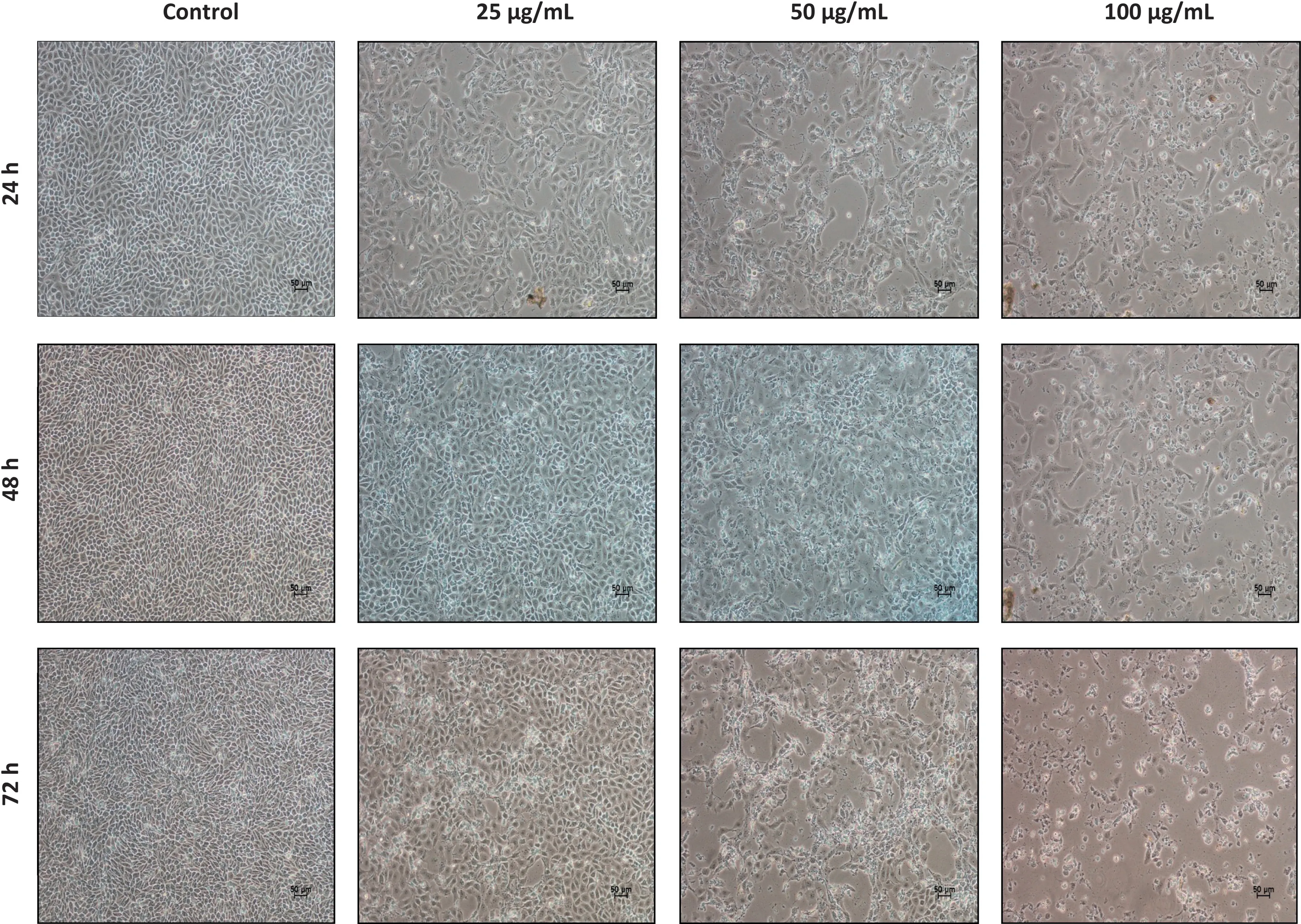
Fig.8. Morphological changes of MCF-7 cells treated with different concentration of CTs of L.leucocephala hybrid-Rendang for 24,48 and 72 h.The cells population was reduced in concentration-dependent manner as compared to untreated cells(100×magnification)
The present finding was in agreement with previous finding in which the plant extract extracted from various sources have shown to possess antitumor-promoting effects especially on human breast cancer cells.The condensed tannins from catechu(a traditional astringent)potently suppress the growth of MCF-7 breast cancer cells, and the effect was related to their activity of fatty acid synthase (FAS) inhibition [43]. The inhibition of both FAS activity and MCF-7 growth was exhibited by low concentrations of condensed tannins without FAS being precipitated. The results was similar with the present finding(cytotoxicity towards MCF-7) and suggests that CTs could be used as valuable resources for bioactive substances related to its cytotoxic properties.
3.5.1. Morphology of cancer cells treated with CTs of L.leucocephala hybrid-Rendang
As illustrated,the untreated cells(HepG2,MCF-7 and HT29)were distributed evenly with increase in the proliferation of the cells in 24, 48 and 72 h of incubation period (Figs. 6–8). In contrast,the most prominent changes including detachment of the cells from substratum, irregular in shape and size and cell shrinkage were observed in the cells treated with CTs.Besides that,some of the cells showed membrane blebbing and as well as formation of apoptotic bodies which regarded as one of the characteristic of apoptosis (Fig. 9). These cellular changes are the characteristics of the apoptotic induction of cell death which suggested that programmed cell death(apoptosis)could be the major factor contributing to the inhibition of cancer cell growth[44].
Apoptosis is a programmed cell death that removes or eliminates targeted unwanted or dead cells.Other than shrunken cells,characteristics of apoptotic cells include condensation of the cytoplasm and nucleus, aggregation of chromatin, and formation of membrane-bound vesicles known as apoptotic bodies[45]. Most of the cancer cells including MCF-7 which treated with plant extract showed apoptosis formation[46–48].Unlike antioxidant agents act by preventing the onset of cancer during carcinogenesis and generally beneficia to cells,cytotoxic agents will damage the tumor cells which produced apoptotic bodies.Further studies on the pathway of cell death would help to fin a novel active natural compound for cancer.
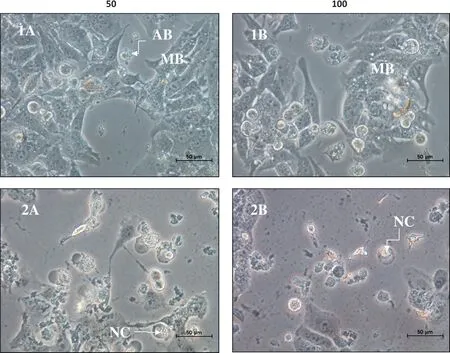
Fig.9. Close-up views of HepG2(1A and 1B)and MCF(2A and 2B)cells treated different concentration of condensed tannins of L.leucocephala hybrid-Rendang for 72 h viewed under an inverted light microscope.The cells showed characteristics of apoptosis such as nuclear compaction(NC)and membrane blebbing and as well as formation of apoptosis bodies(AB)(400×magnification)
4. Conclusion
The capability of the CTs extracts to scavenge free radicals in different systems, indicating that they may be useful therapeutic agents for treating various chronic diseases which are more related to oxidative stress associated diseases. The CTs extract showed significan antimicrobial activity, against different pathogens and inhibited cell proliferation and induced apoptosis in MCF-7,Hep G2 and HT29 cancer cells.These preliminary investigations have suggested that the CTs extracted fromL. leucocephalahybrid-Rendang can be used to discover the bioactive natural product that may serve as a leads in the development of new pharmaceuticals in food and as potent antimicrobial and cytotoxic agent. Further studies will be designed to investigate its biomedical applications with a detailed mechanism through appropriate experimental model.
Conflict of interests
The authors declared that they had no conflic of interests.
Acknowledgements
This study was financiall supported by the Universiti Putra Malaysia(RUGS:9199879).Special thanks to one of the author;the late Dr Sieo Chin Chin.
杂志排行
食品科学与人类健康(英文)的其它文章
- The protective effect of dietary fl vonoid fraction from Acanthophora spicifera on streptozotocin induced oxidative stress in diabetic rats
- In vitro neuroprotective potentials of aqueous and methanol extracts from Heinsia crinita leaves
- Bioactive constituents from the leaves of Quercus phillyraeoides A.Gray for α-glucosidase inhibitor activity with concurrent antioxidant activity
- Protective effect of rhizome extracts of the herb,vacha(Acorus calamus)against oxidative damage:An in vivo and in vitro study
- Moringa oleifera:A review on nutritive importance and its medicinal application
